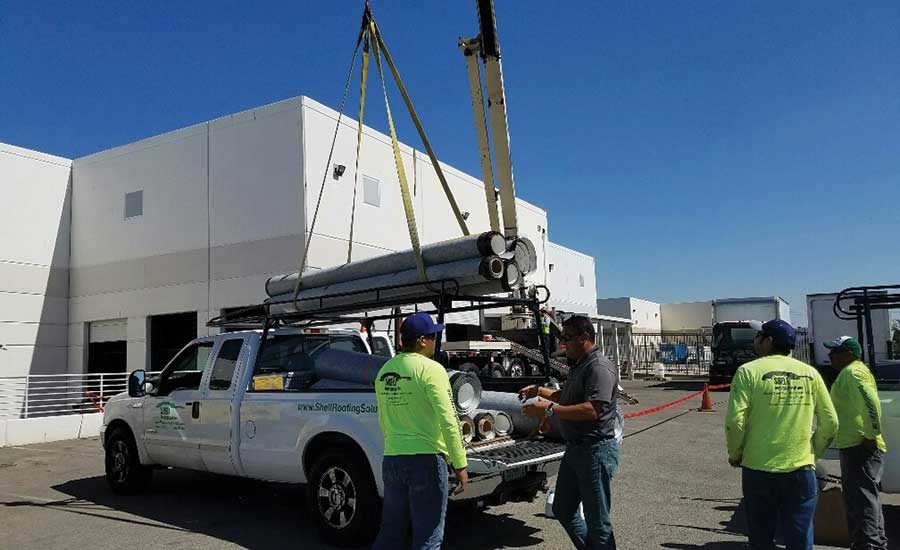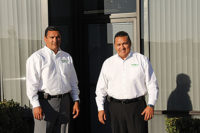Out of their Shell: SHELL Roofing Solutions
Rudy and Hector Gutierrez have a Unique Strategy to Roofing: They View their Business as an Energy Company

Photos courtesy of SHELL Roofing Solutions

"Our skillset is key in project development and gaining the trust of our clients. When you love what you do it transcends," said SHELL Roofing Solutions President and CEO Rudy Gutierrez (below left) who’s seated next to brother and business partner, Hector. Photo by Philip Gudenschwager.

Photos courtesy of SHELL Roofing Solutions.

The U.S. Dept. of Energy estimates that commercial property owners spend more than $1 billion annually to cover energy costs – with heating and cooling being the main usage drivers. Part of the process at SHELL Roofing Solutions is getting California building owners ready for rooftop solar development by first incorporating daylighting and other rooftop strategies to reduce indoor temperatures.

Photos courtesy of SHELL Roofing Solutions.





Rudy Gutierrez is hustling. The calm, laid-back lifestyle many perceive about southern California is about to be interrupted by a much-wanted — yet feared — visitor: Rain.
It’s early December, and the forecast calls for anywhere between 1.5 to 2.5 inches of rain in less than a day’s time. In this part of the country, where a severe drought is about to enter a fifth year, that’s considered a deluge — and Rudy’s phone hasn’t stopped ringing.
“People are in a panic,” he said on the phone while navigating for his business partner and brother, Hector, on the road between client visits. “We’re in a different situation than the rest of the country, and that’s a substantial amount of rainfall in a short amount of time. Guys we’ve been talking to about their situations since before Thanksgiving are now calling us and are all worked up about this water.”
While this brief respite from the state’s ongoing water woes is a welcome occurrence and good for business, waiting for and reacting to the weather is not how the Gutierrez’s have built SHELL Roofing Solutions into a thriving business. The company reported $7.6 million in revenue in 2015, good for the 89th spot on RC’s 2016 Top 100 List. In their market, traditional revenue models and approaches to roofing that sustain roofing companies in other parts of the country just don’t work.
Such is the life of a roofing contractor in Chino, located on the western end of San Bernardino County in the shadows of Los Angeles. And neither Gutierrez brother would have it any other way.
“The (roofing) season seems to last a lot longer here because the spring time is like summer around here,” Rudy said. “And that means there’s a lot of opportunity to grow.”
A True Partnership
If there’s to be a growth spurt in southern California roofing, the Gutierrez’s believe they’ve positioned themselves well at just the right time.
That wasn’t necessarily clear when they branched out on their own in the competitive commercial and industrial roofing market in 2008. To some, it still seems odd that at the height of the recession, both brothers would leave established careers and comfortable positions with some of the larger names in the industry. But they saw an opportunity neither wanted to pass up.
“When people learn that I got out of manufacturing they always say ‘why?’ And I say ‘why not?’” said Rudy, who spent more than two decades at Carlisle SynTec Systems. He was an integral part of the team responsible for training, and the TPO product line growth. He was the national accounts manager in charge of the western United States, Latin America and Asia Pacific when he started his own business. “It’s been the best decision I’ve ever made and the most rewarding phase of my life,” he added.
Part of the draw was the realization of a lifelong dream of entrepreneurship that they say was instilled by their father — an American of Mexican-Italian descent who met his wife while on vacation in Mexico. Another part was the ability to work together as brothers. Hector, Rudy’s younger brother of seven years, established his own career at Carlisle SynTec and spent nearly a decade in distribution with Allied Building Products before starting his own roofing company.
“My brother and I started talking about starting a company,” Hector recalled. “We help other contractors out there all the time. We said: ‘There’s no better time than the present,’ and so we did. It was one of the best moves.”
The pair had worked together before, running a pre-production management company that served the movie industry. Running the construction needs related to movie shoots was a brisk business in their region, and was going well, but both discovered a different calling while on set.
Strangely enough, it started with converting a parking lot into an ocean shoot with waterproofing membranes.
“I first saw the application of single-ply membranes at a movie shoot and that’s where we began to understand these systems,” Rudy explained. “I didn’t understand the science of it yet, but I was just fascinated with the use of these membranes to make swimming pools in parking lots.”
His education came quickly with Carlisle, where he combined his love for technical specifications and his language skills in Spanish and French to become supervisor of technical training. He traveled the world and learned about every type of roofing system in the market, whether residential or commercial, from its manufacturing state to its application.
Hector said he also learned a lot about the technical side of roofing from Carlisle, as well as other best business practices from Rudy.
“I’ve got one of the best, amazing business partners, and he’s also my older brother,” Hector said.
The Strategy
A key component of the decision to start SHELL Roofing Solutions was understanding their surroundings and the market potential.
Despite its proximity to Los Angeles, the San Bernardino region is a haven for light industrial and complex manufacturing that serve the technology and aviation industries. It’s also home to major agricultural and food processing centers that serve the entire country. They were all looking to cut costs as economic pressures of the recession grew and California’s regulatory environment pushed for more renewable energy alternatives.
“The industry was in bad shape, but we knew there were clients out there that still needed to maintain their facilities. So we went out and targeted those in food processing and light manufacturing,” Rudy said.
“You can only fire so many people and close so many plants,” he continued. “So why not attack your consumption to solve the problem?”
Early on, he and Hector knew they wanted to be roofing contractors, but agreed to be a business development firm that focused on reroofing facilities to become energy efficient.
“At the peak of recession we made the decision to invest in ourselves and start our own company. We were different, we had a story and everyone was in cost-reduction mode,” he said.
The U.S. Dept. of Energy estimates that commercial property owners spend more than $1 billion annually to cover energy costs — with heating and cooling being the main usage drivers. As companies struggled to find ways to cut overhead and energy costs, in particular, the demand for solar and other efficiency solutions continued to grow.
During his presentation at the 2016 Best of Success conference, Hector relayed how SHELL helped an auto dealership become solar-ready by first specifying and installing an energy efficient roofing system, utilizing daylighting and automated lighting to address consumption of imported electricity and temperature simultaneously.
“We harvested the daylight and made sure it was lit properly inside,” he explained to the crowd of industry professionals in Marco Island, Fla. “(The owner) started saving money, and we reduced the internal temperature by roughly 25 degrees. That’s huge. That’s really huge!”
He followed up by saying that after 60 days, a report from the company indicated that employees were happier and production was up. The Gutierrez’s said they aim to reduce the amount of imported energy for every client and, in general, try to forecast a return on investment between four and five years.
Rudy is fast to acknowledge he hasn’t done it on his own. He believes the key is having the right people around him and allowing them to build the company into a success — all centered around their go-to market strategy.
“It’s what differentiates our team from our competitors,” Rudy said of the company’s mission statement. “Develop long-term strategies for companies striving to achieve high-level sustainable building solutions for the reduction of imported energy, carbon emission and a contribution to a greener environment.”
Using third-party software and other technology, they’re able to offer clients ‘good, better, best’ scenarios and lead them to the next phase of energy efficiency.
“What we do is leverage the savings versus the cost of investment, and that client is able to take those savings to the CFO and make a good case for doing it. We focus more on the financial side of the improvement rather than on the technical side of it,” Rudy said.
Planning is essential to their success. Rudy said he has long-term relationships with economists at the University of California Los Angeles, officials with the National Roofing Contractors Association (NRCA) and other organizations to compile an annual forecast that analyzes where the market growth is.
“Once we get a good understanding of where that growth is, we target that market. And we stick to that plan for the entire year,” he explained. “It helps us cut out all of the running around chasing empty leads, and focusing on very specific parts of the market.”
Having the ability to communicate well with each other also benefits the client.
“The great thing is that we’re able to speak to each other without the need for large explanations,” Rudy said of his younger brother. “We both know how to do things, are technically proficient, and it’s very easy. It helps us build a better relationship with our client because we’re speaking the same language.”
The Next Wave
Just as important as being active in the roofing industry is for both of them, the Gutierrez’s are looking forward to leaving a lasting imprint with a second generation of roofers in the family. Both have sons that are interested in the business and are actively part of the succession plan still under development, the elder Gutierrez said.
Matt Gutierrez, Rudy’s youngest son, is 24 and a recent graduate of Westwood College with a degree in construction management. Rudy said he’s currently part of the team in a limited capacity while still attending school. Focused on the operations side of the business, he’s following up his construction degree with an advanced degree in construction engineering from California State Polytechnic University, Pomona. The plan is for him to stay involved and learn the business, while also becoming involved in industry initiatives like the Roofing Industry Alliance for Progress and the young executive program offered through the NRCA.
Also joining him will be Hector’s oldest son, Hector Jr., who just returned from military service and will start attending school with a focus on construction management.
“It makes me feel good to know that our family will remain in the business, and very proud to know that someday they’ll be the owners of the company and maybe take it to a place in the industry where I couldn’t,” Rudy said.
Just as important as growing the business in time for the transition, the Gutierrez’s said they hope they’ve created a model of working together and maintaining business and familial harmony at the same time, that the next generation can emulate.
“It’s not always roses, but first we’re brothers and that’s by far more important than the business side of it,” Rudy said. “We keep that in perspective and it allows us to work with each other. We each have our own responsibilities in the business and we’re going at it together. The implications of us failing are enormous for both of us, which keeps us on top of things.”
Looking for a reprint of this article?
From high-res PDFs to custom plaques, order your copy today!











